Sponsored By
ROCK
HARDWARE
Chockstone Photography
Australian Landscape Prints |
General Climbing Discussion
| Author |
|
|||||
10:55:33 PM |
OK so the situation is your 40m up a 46m single pitch, on a 50m (red) rope. Leader needs to bail. he has an additional 50m (blue) rope on his back. Leader needs to bail. Just accept the situation for what it is please. Just brainstorming this hypothetical, and i swear i must be missing a trick here to safely get to the ground and leave minimal gear behind???? Notes: A) this is with a dodgy top anchor so some form of redundancy is desired. Ideally at no point in time is the climbers ONLY protection the top anchor. B)For this scenario, leaving some pro + biner is acceptable. leaving a rope is not 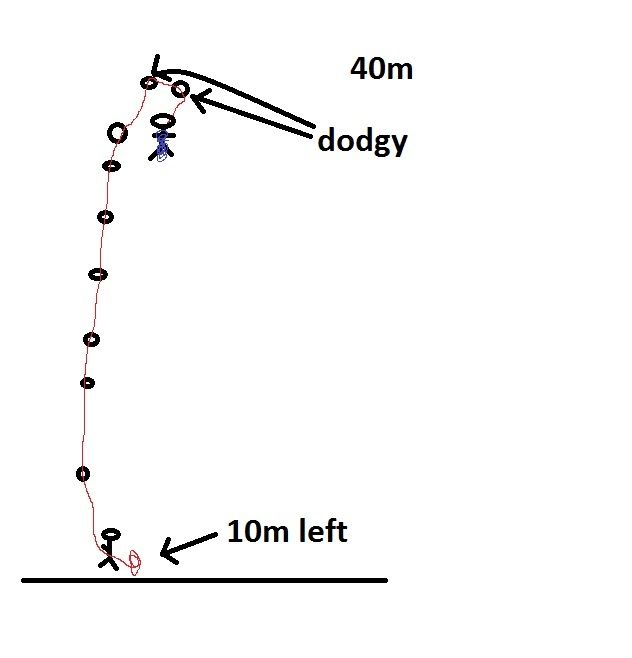 Possible solutions: 1) Lowering off. Obviously wont work. either on the top piece while cleaning, prusik method and cleaning, or just leaving it all in. I Don't see how it could work, without using solution 4 Pros/cons: NA No picture required 2) Downclimb, cleaning as you go. Pros: retrieve all gear, falling potential limited to a normal lead fall. cons: time consuming, difficult, sketchy, scary No picture required 3) Rap on 2nd rope: Attach blue rope to top anchor, rappel on blue rope, clean red rope on way down, while belayer pulls in slack as it is created. Pros: safest, quickest method? dodgy top anchor is made redundant, as a fail would only result in a normal leader fall on the red rope. Cons: serious hassle to retrieve rope+anchor once your on the ground. unless I'm missing something completely? (for this scenario, leaving some pro + biner is acceptable. leaving a rope is not) 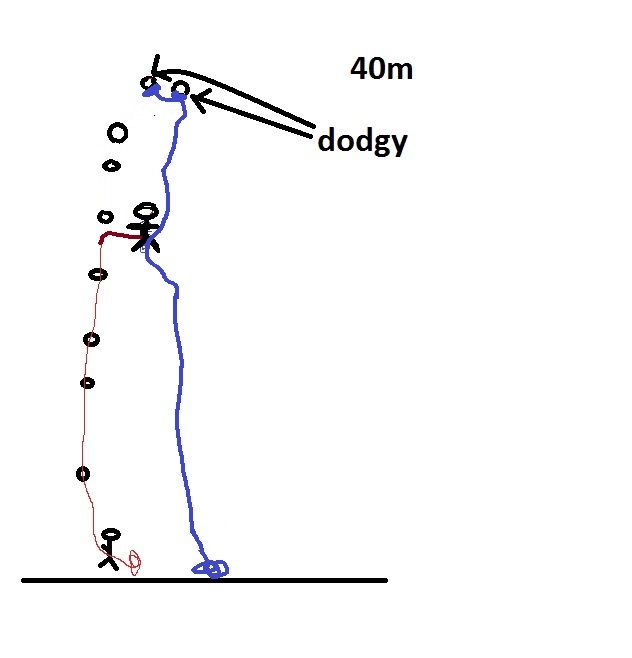 4) Joining ropes: Climber ties blue rope to harness, throw blue rope down to belayer, with just the blue rope through the top anchor. Belayer, joins the ends of the rope, forming a 100m loop. Belayer lowers using the blue rope, while taking in slack on the red rope. climber cleans on the way down, no prusik required. On ground, pull blue rope to retrieve both ropes. Pros: redundant. Top piece popping = normal leader fall. all gear is retrieved (minus top anchor which is ok). Cons: Technical belaying. Serious problem if you throw blue rope down and it gets stuck before reaching ground. 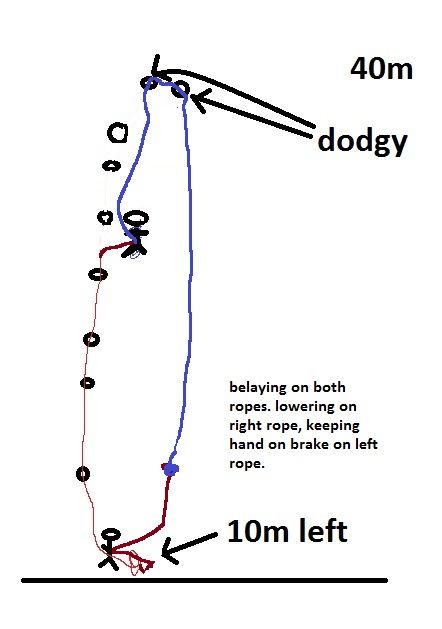 5) Form a loop in red rope, attach blue rope to loop. rappel blue line. cleaning via the Prusik method Pros: redundant. Top piece popping = normal leader fall. all gear is retrieved (minus top anchor which is ok). I feel like this is the safest, but also slowest method? Cons: possibly more faffing about than option 4? 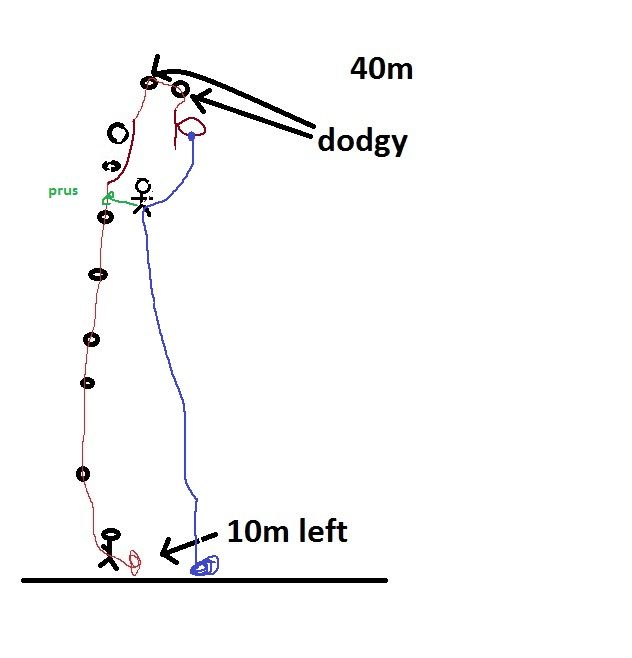 thoughts? Im drawing up some diagrams now |
|||||
11:21:14 PM |
Keep your options open until it is no longer a hypothetical and then make a decision based on the specifics of the situation. | |||||
11:27:06 PM |
Looking for "possible options" here. so my options are as open as possible, when the need arises. just tried drawing a diagram of option 4, and it doesnt even work lol, not sure how it was working in my head. (fixed the idea so it would work, edited first post) |
|||||
11:37:17 PM |
Most of those options could work. I think what you actually need is a heuristic to help decide between the options. For instance: If either party member is injured more expedient methods may be preferable to leaving as little gear behind as possible. If you will have more abseils to do to reach the ground methods that dont involve leaving a fixed rope, or excessive gear will be preferable. If you can just walk to the top of the cliff abseil down and retrieve you gear, then it probably doesnt matter, leave all the gear behind, and spend an extra half hour getting it out on rap. If you don't trust the gear, and the climbing is hard, down climbing will not be appealing. If you don't trust the gear, and the climbing is easy, down climbing will be appealing. Etc, etc, etc. |
|||||
12:15:25 AM |
The trouble with such a scenario are the big variables that will influence any decision made. These include the ability of the the climber, the difficulty of climbing above and below the climber and the quality of the protection. Rarely is there a one-size-fits-all answer to climbing situations. Judgment, experience and ability all need to be considered. And what is right for one climber isn't necessarily right for another. But if you want an answer... Climber threads spare (blue) rope through top dodgy pieces and raps down on both ends until 25m above belay (having unclipped the red rope from the top pieces prior to rapping). In the process the climber is kept on belay on the red rope as he/she cleans the pitch on the way down. At the 25m mark (providing there is good gear), the climber transfers their weight to the red rope and then pulls the blue rope clear from the top pieces. The climber then gets lowered on the red rope to the ground, cleaning the rest of the pitch on the way down. That means the climber has left behind the 2 dodgy pieces up high and the one bomber piece at the 25m mark (providing you are happy to be lowered off one piece at that point). |
|||||
1:10:53 AM |
Down climb until you get to a solid piece of gear, Back it up with a couple of other solid pieces of gear ( at least one). Equalise those little rascals with your least favourite carabiner .making sure you don't unclip from the initial piece of gear you climbed down to. (otherwise you wouldn't be on belay) Take a sling or a quickdraw and clip in short to the anchor like your'e a sport climber. Draw up some slack on the lead rope and tie a figure eight on a bite with a meter or so of slack. Clip into that (you are still on belay) with a screwgate biner and then untie initial tie in knot. Tie the end of the lead rope and your weird back rope together. Attach your belay/rappel device to the rope,making. sure all the knots are on one side of the anchor. Unclip from the figure eight on a bite. Abseil very gingerly. If shit scared, clip into (with the unknotty side of the rope) to any solid gear on the way down. It probably won't save you but you'll seem to be less shit scared If you find a bolt or a tree, repeat the above, with less fear. Often down climbing to a better stance, having a bit of a rest (up to 30 mins) and then going for it, can work. Sometimes it doesn't. Climbing with both ropes, actually tied to you, could help to. |
|||||
8:17:21 AM |
all good ideas, I like 4. - Down-climbing is the ultimate form of protection on scary traD (my baby hit the keyboard and invented a new word here, like jamB; I'll have to tell macca) -I wouldn't trust the down-prussic idea unless you'd tested that prussic/rope size combination for falling loads (they are generally ok for bodyweight) - as said earlier, it depends on the gear. - being lowered puts almost twice the load as lowering yourself - if you put 2 ropes through 2 seperate pieces if halves the load again if we assume that the three top pieces will each take bodyweight, I'd equalise them all and set up an abseil on the 2 ropes tied together and threaded so you can pull them down. Have the belayer keep you on belay and rap on munter hitches (probably each rope on a seperate biner, stagger the hieghts of the biners so they don't jamb). Munters because they are reversible and have enugh friction to catch a fall. keep one hand on each side of the munter, so that, if the top anchor fails, you can hold the new anchor strand and brake the rope running through your runners and down to the belayer (who is giving you a bludysoft catch) 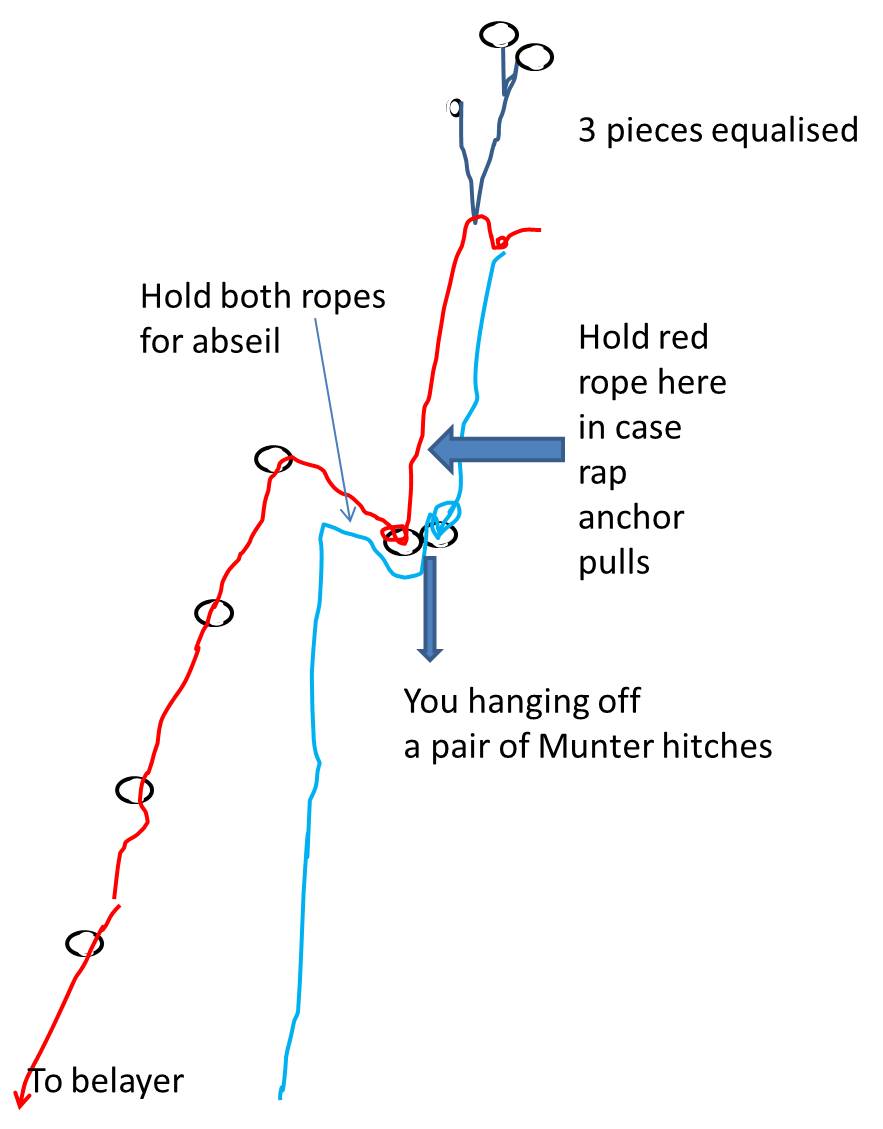 |
|||||
6:40:17 PM |
your stick man looks like hes having a hard time carrying that blue rope. why not be climbing on both? |
|||||
6:55:26 PM |
Sometimes you've got to leave gear up there. if you only had the red rope. find your best spot for making an anchor, make the anchor and yourself safe, thread it, tie knot in end, rap..oh and check ur rope will pull! clean your gear on way down, find your next spot for making a reasonable anchor and do the same thing until your on the ground. |
|||||
9:24:27 PM |
On 8/09/2013 mikllaw wrote: >all good ideas, I like 4. >- Down-climbing is the ultimate form of protection on scary traD (my baby >hit the keyboard and invented a new word here, like jamB; I'll have to >tell macca) Good one! ;-) (snip) >- being lowered puts almost twice the load as lowering yourself >- if you put 2 ropes through 2 seperate pieces if halves the load again > (snip) From the link provided ('Prusik Method', contained in Frostex original post), Petzl reckons the following... 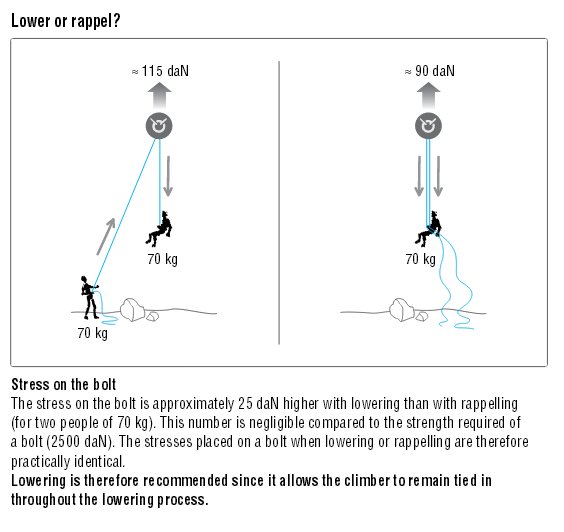 ... This is possibly the first time I have seen such low numbers used, and my old fashioned rule of thumb is like Mikl's, ie consider the loading on the anchor when being lowered to be twice your bodyweight. Thoughts from the engineering lot? |
|||||
10:37:37 PM |
On 8/09/2013 IdratherbeclimbingM9 wrote: >... This is possibly the first time I have seen such low numbers used, >and my old fashioned rule of thumb is like Mikl's, ie consider the loading >on the anchor when being lowered to be twice your bodyweight. > >Thoughts from the engineering lot? I'm surprised at these measured values, but I think they are correct. At first sight, lowering yourself 'should' be just your bodyweight. Once you factor in carabiner friction, lowering should be about 1.6 x bodyweight. Once you include the real world effects of smoothing out force-spikes, these values change a lot. Abseiling has a short, doubled length of rope, which is very stiff, so jolts don't get damped out much leading to higher peak loads than lowering (as lowering has a much longer length of single rope, which is a miuch softer spring and reduces the peaks more). I'd still do a careful self lower and have a very soft catch from below as per my method:- if your top anchors fail while being lowered, theres a lot of slack and a long fall to be caught on poor gear. If they fail on the rap method, the fall is much less. Or just harden up and downclimb. It's amazing what you can downclimb when there's no alternative. |
|||||
11:42:10 PM |
Leading dodgy trad too difficult to finish with a rope tied on your back? Weird, but strangely believable! WITHOUT an extra rope (because, WTF mate?) you could still do it. If your dodgy gear is solid enough to abseil on (see above diagrams) - pull the rope through to halfway point*, abseil down and clean to the best placement around 20m above the deck. CLIP IN Pull the rope down to where you are (watch dodgy piece sail past as you jiggle the rope through) and rethread through two bomber placements clipped to (quote above) your least favourite biner. *If your leader isn't comfortable or safe, lock rope on both strands (same as an abseil) and haul the rope up & then belay the loose end through... time consuming and difficult, best to downclimb) ** if not possible to abseil, get lowered to last solid placement, then do the above Use prussicks blahblah etc. WTF mate? |
|||||
12:37:50 AM |
OK, lets see . . I will assume that we are competent capable trad climbers and that there is some good gear on the route and that the falls would be safe. So you are standing above some good gear somewhere in the last few pieces and you were ok climbing and now a dodgy placement has you worried and the belay you want to reach has disappeared. Just how dodgy is that piece? Lets just find out, if you are not sitting on it yet then sit on it. Still a bit worried relax, get into aid mode, it;s at least bodyweight for the moment, 1-2kN thats good Check that the fall is good, (it is), and start bounce testing the placement, gently then increasingly harder - at this point it will either blow and you fall or it will become be a better placement then you thought Cool you just a had a good learning experience re placement quality and surprised yourselve one way or the other and you can continue with our descent, downclimb or backjumping or a bit of both, or rap if you must . . . Once back down to half rope height keep an eye out for nice horns or good threads that can be used for rap points. Find a nice horn and hang your spare rope over it then rap on the doubled line then pull rope down If there are no suitable natural rap anchors then place a single med to large nut or hex in a bomber place and just lower or rap from that. You should be able to get back down pretty quickly like this |
|||||
8:54:10 AM |
Assuming the leader isn't injured, why not go into aid mode and get up a bit higher to one or two bomber placements and then use them as an anchor and abseil down? | |||||
12:53:21 PM |
On 10/09/2013 Mike Bee wrote: >Assuming the leader isn't injured, why not go into aid mode and get up >a bit higher to one or two bomber placements and then use them as an anchor >and abseil down? Heh, heh, heh. Original post said; >OK so the situation is your 40m up a 46m single pitch, (snip) ... being that close to topping out, I'd aid the whole distance! ☺ |
| There are 15 messages in this topic. |
Home | Guide | Gallery | Tech Tips | Articles | Reviews | Dictionary | Forum | Links | About | Search
Chockstone Photography | Landscape Photography Australia | Australian Landscape Photography | Landscape Photos Australia
Please read the full disclaimer before using any information contained on these pages.
Australian Panoramic |
Australian Coast |
Australian Mountains |
Australian Countryside |
Australian Waterfalls |
Australian Lakes |
Australian Cities |
Australian Macro |
Australian Wildlife
Landscape Photo |
Landscape Photography |
Landscape Photography Australia |
Fine Art Photography |
Wilderness Photography |
Nature Photo |
Australian Landscape Photo |
Stock Photography Australia |
Landscape Photos |
Panoramic Photos |
Panoramic Photography Australia |
Australian Landscape Photography |
High Country Mountain Huts |
Mothers Day Gifts |
Gifts for Mothers Day |
Mothers Day Gift Ideas |
Ideas for Mothers Day |
Wedding Gift Ideas |
Christmas Gift Ideas |
Fathers Day Gifts |
Gifts for Fathers Day |
Fathers Day Gift Ideas |
Ideas for Fathers Day |
Landscape Prints |
Landscape Poster |
Limited Edition Prints |
Panoramic Photo |
Buy Posters |
Poster Prints
